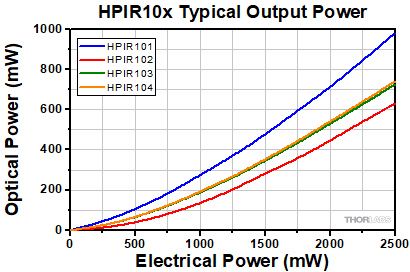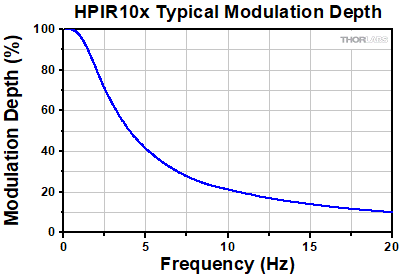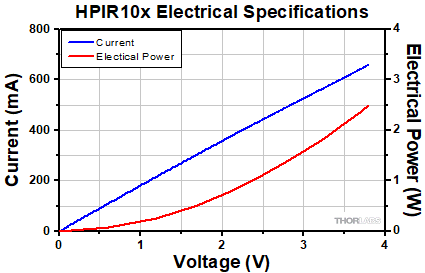High-Power IR Emitters

- Pulsable Thermal Near-Blackbody IR Sources
- Available with Soldered Filter Windows
- TO-8 Can Package
- SM1-Threaded Mounting Adapter Available Separately
HPIR101
2 - 16 µm, No Window
HPIR103
2 - 14 µm, BaF2 Window,
Winston Cone
HPIR102
2 - 6 µm, Al2O3 Window
Application Idea
HPIR104 High-Power IR Emitter Mounted in the HPIRM SM1-Threaded Mounting Adapter

Please Wait

Click to Enlarge
The typical output power for Thorlabs' High-Power IR Emitters. Additional performance details can be found on the Graphs tab.
| Key Specificationsa | ||||
|---|---|---|---|---|
| Item # | HPIR101 | HPIR102 | HPIR103 | HPIR104 |
| Wavelength Range |
2 - 16 µm | 2 - 6 µm | 2 - 14 µm | 2 - 11 µm |
| Window | N/A | Soldered Sapphire |
Soldered BaF2 |
Soldered CaF2 |
| Collimator | N/A | N/A | Winston Cone | |
| Gas Filling | N/A | N2 | ||
Features
- Pulsable Broadband Output
- Near-Blackbody Emittance
- Nanostructured Radiating Element
- Available With or Without Soldered Windows
- TO-8 Can Package
- Externally SM1-Threaded (1.035"-40) Mounting Adapter Available Separately
Thorlabs' High-Power IR Emitters are pulsable, thermal blackbody sources that feature a 40 mm2 emitter area and >0.9 emissivity over a broad spectral range. Each emitter features a free-standing monolithic radiating element, which offers improved efficiency as well as better mechanical stability and shock resistance compared to wound filaments. The radiating element is made of high-melting point metal with a nanostructured surface that increases the optical emissivity. To achieve maximum efficiency, each emitter also includes an integrated reflector that directs the backside emitted radiation towards the front of the housing.
The emitters are available with open housings (HPIR101) or hermetically sealed with soldered windows made from sapphire (HPIR102), barium fluoride (HPIR103), or calcium fluoride (HPIR104). Versions with soldered windows are suitable for the measurement of flammable gases. The soldered windows are leak tested and offer improved long term stability compared to conventional glued windows. All sealed IR emitters are filled with nitrogen gas; please contact Tech Support for other gas fillings. The HPIR103 and HPIR104 models feature a Winston cone collimator, narrowing the emission angle of the emitted radiation.

Click to Enlarge
HPIR102 Bulb Mounted in HSLT2 Heatsink Lens Tube
with CaF2 Plano-Convex Lens Using HPIRM Mounting Adapter
The HPIRM Mounting Adapter has external SM1 (1.035"-40) threads that enable the HPIR bulbs to be integrated into our Ø1" Lens Tube Systems and SM1-Threaded Kinematic Mounts. The bulb is held in the HPIRM mount using an SM17RR Ø17 mm Retaining Ring (included), which can be tightened using our SPW801 Adjustable Spanner Wrench. The adapter can be installed in an SM1-threaded lens tube or mount using the SPW909 or SPW801 Spanner Wrenches.
Please note that the housing of the emitter will heat up during operation. Although operation without a heatsink is possible without damaging the emitter, we recommend using a suitable heatsink like the HSLT2 passive-heat-sink lens tube in combination with the HPIRM mounting adapter for long term operation. An example is depicted to the left.
While these emitters can be driven by any power source respecting the current and power limits given in the Specs tab, we recommend using our basic LEDD1B driver. The wires of the driver's connection cable can be attached directly to the leads of the emitter.
| Item # | HPIR101 | HPIR102 | HPIR103 | HPIR104 |
|---|---|---|---|---|
| Wavelength Range | 2 - 16 µm | 2 - 6 µm | 2 - 14 µm | 2 - 11 µm |
| Radiating Element Emissivity | >0.9 | |||
| Modulation Deptha | 70% at 2.5 Hz | |||
| Maximum Current | 660 mA | |||
| Maximum Voltage (Typical) | 3.8 V | |||
| Maximum Electrical Power (DC)b | 2.5 W | |||
| Electrical Resistance (Typical) | 5 - 6 Ω | |||
| Radiating Element Area (Emitter Size) | 40 mm2 | |||
| Housing Type | TO-8 | |||
| Window | N/A | Soldered Sapphire | Soldered BaF2 | Soldered CaF2 |
| Collimator | N/A | N/A | Winston Cone | |
| Gas Filling | N/A | N2 | ||
| Radiating Element Temperature (Typical) | 630 °C | |||
| Operating Temperature (Non-Condensing) | -25 °C to 85 °C | |||
| Storage Temperature | -25 °C to 85 °C | |||
| Typical Lifetime | >30 000 h | |||

Click to Enlarge
Click for Raw Data
Each spectrum above is normalized to its peak and compared to the blackbody spectrum at the equivalent temperature.
| Posted Comments: | |
諒一 芝山
(posted 2024-04-02 12:14:49.067) モジュール評価系への採用を検討しております。
zemaxで使用できる光源データ(NFP)を頂くことは可能でしょうか? dpossin
(posted 2024-04-02 10:58:02.0) Dear customer,
Thank you for your feedback. Unfortunately we can´t provide zemax files for our thermal emitters. I reach out to you in order to clarify open questions. Thomas Produit
(posted 2023-11-27 11:32:04.437) Hi,
Is there somewhere a graph explaining which pin to solder to which colored wire when hooking up for example the HPIR10X to the LEDD1B ?
Thanks in advance ! dpossin
(posted 2023-11-27 05:11:09.0) Hello Thomas,
Thank you for your feedback. Since our high power emitters are thermal emitters there is no prefered pin configuration. Either way it will work. dpossin
(posted 2023-11-27 05:11:09.0) Hello Thomas,
Thank you for your feedback. Since our high power emitters are thermal emitters there is no prefered pin configuration. Either way it will work. David Kappel
(posted 2023-11-11 09:18:12.32) Is there a graph of the angular output? Could I collimate with a lens? Is the angular output narrow enough to put a highpass thinfilm filter to narrow the spectrum? dpossin
(posted 2023-11-17 05:46:12.0) Dear Dave,
Thank you for your feedback. I´ll reach out to you directly in order to discuss you application in more detail. user
(posted 2023-06-02 08:31:52.077) How to connect safely the HPIR103 / HPIR104 pins to a power supply ? Do you provide any socket ? hchow
(posted 2023-06-02 11:28:01.0) Dear User, thank you for your feedback. We sell the HPIRM mount adapter for use with our High Power IR Emitters. user
(posted 2023-05-17 10:07:35.863) What's the angular emission pattern of 103? hchow
(posted 2023-05-18 09:54:08.0) Dear User, thank you for your feedback. I will personally reach out to you about this issue. Thank you. Sam Rubin
(posted 2022-10-19 09:16:35.833) can those be operated with a constant voltage supply? or do they require pulsed voltages.
Thanks
Sam dpossin
(posted 2022-10-21 06:08:44.0) Dear Sam,
Thank you for your feedback. In general the efficiency of the IR emitters is the highest when driven with constant voltage sources. However it is also possible to pulse them using pulsed sources. When doing so the average light intensity depends on the pulse frequency and pulse width. The dependency can be seen in the datasheet. I am reaching out to you in order to give further adivce. Constantin SANDU
(posted 2022-07-01 20:44:25.44) Dear Sirs,
I do not find information about the power of your product HPIR104 - High-Power IR Emitter.
Please, send me the power value.
Best regards,
Constantin
(constantin.sandu@comoti.ro) GBoedecker
(posted 2022-07-06 10:46:15.0) Dear Constantin, thank you for your feedback! You can find the power plot in the "Graphs" tab on the website or in the specsheet, downloadable from the "Docs" column. 明琪 庞
(posted 2022-06-17 09:06:12.26) 请问网站上给出的归一化光谱曲线是在什么条件下测量的?
在使用过程中可以改变 Electrical Power吗?如何改变?改变之后输出的光谱曲线如何变化?
HPIR101是点光源吗? Woongki KIM
(posted 2022-04-07 11:03:04.567) I'm Kim Woongki from GASTRON R&D
I'm reviewing the IR Source to THORLABS.
Ray File is required for optical design.
We are using 'Ansys Speos'. (Optical design tools)
Could you send me the Ray file for the model below?
- HPIR103
- HPIR101
- HPIR102
- HPIR 104 soswald
(posted 2022-04-13 03:29:47.0) Dear Kim Woongki,
thank you for your feedback. I have reached out to you directly to provide further details. Junyu Li
(posted 2022-03-09 21:09:38.877) Hello, I would like to know how to safely power the HPIR103 in TO-8 package? Do you have any accessories? Thank you! soswald
(posted 2022-03-14 05:17:58.0) Dear Junyu Li,
thank you for your feedback. I have reached out to you directly to discuss your application in more detail. |
 Products Home
Products Home














 High-Power IR Emitters
High-Power IR Emitters